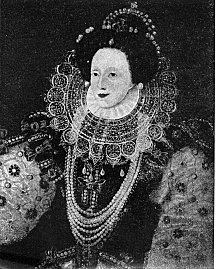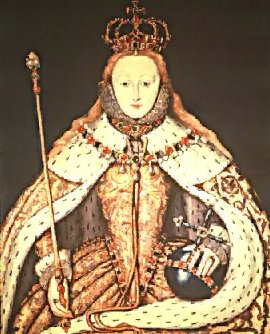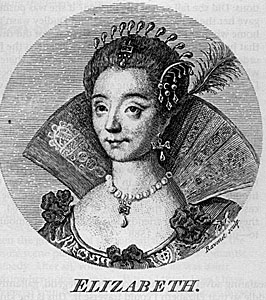
 lizabeth (1533-1603), queen of England, only child
of Henry VIII by Anne Boleyn, was born in Greenwich Palace on
Sept. 6, 1533. Till she ascended the throne, she did not play an
important part in English politics. On the death of her half-brother,
Edward VI, she took the side of Mary against Lady Jane Grey and
the duke of Northumberland, but her identification with
Protestantism aroused the suspicion of Mary, and led to her being
implicated in Wyatt’s rebellion in 1554, and thrown into the
Tower. Subsequently she was strictly guarded at Woodstock, and
her conformity to the Catholic ritual was probably the sole cause
of her not being sent to the block.
lizabeth (1533-1603), queen of England, only child
of Henry VIII by Anne Boleyn, was born in Greenwich Palace on
Sept. 6, 1533. Till she ascended the throne, she did not play an
important part in English politics. On the death of her half-brother,
Edward VI, she took the side of Mary against Lady Jane Grey and
the duke of Northumberland, but her identification with
Protestantism aroused the suspicion of Mary, and led to her being
implicated in Wyatt’s rebellion in 1554, and thrown into the
Tower. Subsequently she was strictly guarded at Woodstock, and
her conformity to the Catholic ritual was probably the sole cause
of her not being sent to the block.
On the death of Mary, Nov. 17, 1558, Elizabeth, then twenty-five
years of age, was summoned to the throne. To an exceptional
extent Elizabeth’s history was bound up with that of England.
For the significant political events of her reign, see England
and Wales; for ecclesiastical affairs, Reformation; and for the
Spanish attempt at conquest, Armada.
 From her
sixteenth to her fifty-sixth year, one matrimonial scheme or
passion, not always remarkable for delicacy, succeeded another.
Before she ascended the throne, her name was mentioned in
connection with Admiral Lord Seymour; Edward Courtenay, son of
the earl of Devonshire; the earl of Arran; Philip of Spain, who
married Mary; and Philibert of Savoy. After she became queen,
Philip renewed his courtship, while her hand was also solicited
by or for Eric, king of Sweden, Henry III of France, his
successor Henry of Navarre, the Archduke Charles of Austria, and
the duke of Alencon. Her heart was probably most touched, however,
by Robert Dudley, earl of Leicester, an accomplished courtier.
After Leicester’s death, Robert Devereux, second earl of
Essex, succeeded to his position as favorite, but was eventually
beheaded in 1601.
From her
sixteenth to her fifty-sixth year, one matrimonial scheme or
passion, not always remarkable for delicacy, succeeded another.
Before she ascended the throne, her name was mentioned in
connection with Admiral Lord Seymour; Edward Courtenay, son of
the earl of Devonshire; the earl of Arran; Philip of Spain, who
married Mary; and Philibert of Savoy. After she became queen,
Philip renewed his courtship, while her hand was also solicited
by or for Eric, king of Sweden, Henry III of France, his
successor Henry of Navarre, the Archduke Charles of Austria, and
the duke of Alencon. Her heart was probably most touched, however,
by Robert Dudley, earl of Leicester, an accomplished courtier.
After Leicester’s death, Robert Devereux, second earl of
Essex, succeeded to his position as favorite, but was eventually
beheaded in 1601.
The reign of Elizabeth was a remarkable period in English
history. There was comparatively little domestic trouble, no
foreign wars were waged, religious persecution had virtually
ceased, and the people were free to turn to the pleasures and the
arts of peace. Literature rose to unsurpassed heights, producing
such masters as Shakespeare, Bacon, Spenser, Marlowe, Sidney,
Ascham and Hooker, while in the more practical walks of life came
Drake and Frobisher. Consult Strickland’s Lives of the
Queens of England; Froude’s History of England
(vols. vii-xii); Creighton’s Queen Elizabeth;
Hassall’s The Tudor Dynasty; Beesley’s Queen
Elizabeth; Stachey’s Elizabeth and Essex. [World
Wide Illustrated Encyclopedia, 1935]
 Elizabeth
I (1533-1603), queen of England and Ireland (1558-1603),
daughter of Henry VIII, king of England, and of his second wife,
Anne Boleyn. She was the last of the Tudor rulers of England.
Although her legitimacy was questioned and never settled (because
an act of Parliament [1536] invalidated the marriage of her
parents and enabled Henry to marry his third wife, Jane Seymour),
both Parliament and Henry named as heirs to this throne his
children Edward, later Edward VI; Mary, later Mary I; and
Elizabeth, in that order.
Elizabeth
I (1533-1603), queen of England and Ireland (1558-1603),
daughter of Henry VIII, king of England, and of his second wife,
Anne Boleyn. She was the last of the Tudor rulers of England.
Although her legitimacy was questioned and never settled (because
an act of Parliament [1536] invalidated the marriage of her
parents and enabled Henry to marry his third wife, Jane Seymour),
both Parliament and Henry named as heirs to this throne his
children Edward, later Edward VI; Mary, later Mary I; and
Elizabeth, in that order.
Childhood and Accession as Queen
Born in London on September 7, 1533, Elizabeth spent her
childhood away from the court and received an excellent classical
education under such scholars as Roger Ascham, who influenced her
greatly. Henry’s sixth wife, Catherine Parr, later became
fond of the young Elizabeth and brought her back to court. She
remained in Catherine’s charge after Henry’s death and
took no part in the political intrigues following the coronation
of her brother as King Edward VI. When Edward died, Elizabeth
became a partisan of her sister Mary, refusing to support the
revolt led by the English soldier and conspirator Sir Thomas
Wyatts, Mary, a devout Roman Catholic, was made uneasy by the
Protestantism of Elizabeth and her potential menace as an heir to
the throne. In 1554, Elizabeth was imprisoned on the false charge
of having been implicated in Wyatt’s rebellion. She was
later released, having outwardly professed Roman Catholicism, and
regained Mary’s favor.
At the death of Mary in 1558, Elizabeth became queen,
beginning one of the greatest reigns in English history. At the
time of Elizabeth’s accession, England was torn by religious
strife, was economically insecure, and was involved in a
disastrous war with France. To these problems Elizabeth brought a
thorough education, innate shrewdness, and a skill in diplomacy
that she had constantly exercised during the reigns of Edward and
Mary, when one mistake might have meant her death. Although she
was excessively vain and capricious, her monarchial duties were
always her primary concern. Her policies and her colorful
personality made her extremely popular with her subjects.
Elizabeth’s statecraft was due, to a great extent, to her
choice of able and wise advisers, most notably Sir Francis
Walsingham and William Cecil, 1st Baron Burghley.
Religion was Elizabeth’s initial problem as queen. She
reverted to Protestantism immediately after Mary’s death,
and her first Parliament (1559) had a Protestant majority.
Between 1559 and 1563, this Parliament passed religious
legislation that became the doctrinal basis of the Church of
England. In the Elizabethan Compromise (1559), the Church of
England became the established church, and throughout Elizabeth’s
reign Roman Catholics and Puritans were persecuted.
 A Popular Queen
A Popular Queen
Elizabeth’s domination of the period to which her name
became attached was due in part to the exuberant national spirit
that she inspired and that characterized all England during the
second half of the 16th century. She restored popular confidence
in the monarchy, and a wave of prosperity swept every field of
endeavor. With the religious question settled and the war with
France concluded by the Treaty of Cateau-Cambrésis (1559),
England was able to develop industrially and economically. Under
Elizabeth’s direction, the government began to regulate
commerce and industry on a national scale. England grew to be a
great maritime power with the exploits of such mariners as Sir
Francis Drake and Sir Martin Frobisher. A new system of standard
coinage was introduced in 1560 to replace the silver coins that
had been considerably debased during the preceding three reigns.
As a result, prices fell to normal levels and confidence in
English money was restored. Foreign trade, encouraged by the
government, became a great capitalistic enterprise. The Royal
Exchange of London was opened in 1566, and the company of
merchants that later became the English East India Company was
chartered in 1600. Above all this activity stood the figure of
Elizabeth. In the eyes of her subjects, Elizabeth was England.
From the beginning of her reign, Elizabeth’s marital
status was a political concern because there was no English heir
to the throne. Parliament insistently petitioned her to marry,
but she replied with the statement that she intended to live and
die a virgin, and she became known as the Virgin Queen. Her
statement did not prevent her from toying constantly with the
idea of marriage. She was besieged by royal suitors, each of whom
she favored when it was in her political interest to do so. Her
affections, however, were bestowed on a succession of favorites,
notably Robert Dudley, 1st earl of Leicester, Sir Walter Raleigh,
and Robert Devereux, 2nd earl of Essex.
Elizabeth’s most delicate political problem was that
involving her Roman Catholic cousin, Mary, queen of Scots. Mary
sought refuge in England after being defeated in battle by her
half brother, James Stuart, earl of Moray. Elizabeth immediately
imprisoned Mary because the Catholic monarchs of Europe and her
own Catholic subjects considered Elizabeth illegitimate. By their
reasoning, Mary was the lawful queen of England. Thus, to
Elizabeth, Mary was the potential center of conspiracy. Mary was
kept captive for years, giving rise to many plots by English
Catholics for her release. When in 1586 Walsingham, then
secretary of state, discovered a plot to assassinate Elizabeth
and place Mary on the throne of England, Elizabeth reluctantly
agreed to have Mary executed in 1587. The execution had serious
results. Philip II of Spain had, for years, been troubled by the
raids of English mariners on his colonial possessions. Because
both Mary and Philip were Catholic, her death provided him with
an added stimulus to prosecute the war with England that had been
going on since 1585; he therefore sent a fleet to invade the
country in 1588. The Spanish Armada, however, suffered an
inglorious defeat, and England eventually took the place of Spain
as the great colonizer of the New World and the reigning power on
the seas. Moreover, by inflicting such defeat on Catholic Spain,
England established Protestantism as a force in international
politics.
End of an Era
Elizabeth’s popularity waned toward the end of her reign
because of her heavy expenditures and abuse of royal power.
Moreover, her policies became weaker, her later ministers being
less able than Cecil or Walsingham. The close of Elizabeth’s
reign was disturbed by a revolt in Ireland that was led by Hugh O’Neill.
The 2nd earl of Essex, Elizabeth’s favorite, unsuccessfully
led an army against the Irish. When he returned to England, he
led a revolt against the queen and was executed in 1601.
Following his death, Elizabeth was disconsolate. She spent the
last years of her life unhappy and alone, having outlived a
glorious age, the beginning of the history of what would become
modern England. She died in London on March 23, 1603.
In addition to being a time of political triumphs, the
Elizabethan era was notable as one of the greatest periods of
English literature. Edmund Spenser, Christopher Marlowe, and
Shakespeare were only a few of the host of writers who created
their great works under Elizabeth. The dramatic personality of
Elizabeth became the subject of a voluminous literature. [Microsoft
Encarta 98 Encyclopedia]
 Back
Back

 lizabeth (1533-1603), queen of England, only child
of Henry VIII by Anne Boleyn, was born in Greenwich Palace on
Sept. 6, 1533. Till she ascended the throne, she did not play an
important part in English politics. On the death of her half-brother,
Edward VI, she took the side of Mary against Lady Jane Grey and
the duke of Northumberland, but her identification with
Protestantism aroused the suspicion of Mary, and led to her being
implicated in Wyatt’s rebellion in 1554, and thrown into the
Tower. Subsequently she was strictly guarded at Woodstock, and
her conformity to the Catholic ritual was probably the sole cause
of her not being sent to the block.
lizabeth (1533-1603), queen of England, only child
of Henry VIII by Anne Boleyn, was born in Greenwich Palace on
Sept. 6, 1533. Till she ascended the throne, she did not play an
important part in English politics. On the death of her half-brother,
Edward VI, she took the side of Mary against Lady Jane Grey and
the duke of Northumberland, but her identification with
Protestantism aroused the suspicion of Mary, and led to her being
implicated in Wyatt’s rebellion in 1554, and thrown into the
Tower. Subsequently she was strictly guarded at Woodstock, and
her conformity to the Catholic ritual was probably the sole cause
of her not being sent to the block. From her
sixteenth to her fifty-sixth year, one matrimonial scheme or
passion, not always remarkable for delicacy, succeeded another.
Before she ascended the throne, her name was mentioned in
connection with Admiral Lord Seymour; Edward Courtenay, son of
the earl of Devonshire; the earl of Arran; Philip of Spain, who
married Mary; and Philibert of Savoy. After she became queen,
Philip renewed his courtship, while her hand was also solicited
by or for Eric, king of Sweden, Henry III of France, his
successor Henry of Navarre, the Archduke Charles of Austria, and
the duke of Alencon. Her heart was probably most touched, however,
by Robert Dudley, earl of Leicester, an accomplished courtier.
After Leicester’s death, Robert Devereux, second earl of
Essex, succeeded to his position as favorite, but was eventually
beheaded in 1601.
From her
sixteenth to her fifty-sixth year, one matrimonial scheme or
passion, not always remarkable for delicacy, succeeded another.
Before she ascended the throne, her name was mentioned in
connection with Admiral Lord Seymour; Edward Courtenay, son of
the earl of Devonshire; the earl of Arran; Philip of Spain, who
married Mary; and Philibert of Savoy. After she became queen,
Philip renewed his courtship, while her hand was also solicited
by or for Eric, king of Sweden, Henry III of France, his
successor Henry of Navarre, the Archduke Charles of Austria, and
the duke of Alencon. Her heart was probably most touched, however,
by Robert Dudley, earl of Leicester, an accomplished courtier.
After Leicester’s death, Robert Devereux, second earl of
Essex, succeeded to his position as favorite, but was eventually
beheaded in 1601. Elizabeth
I (1533-1603), queen of England and Ireland (1558-1603),
daughter of Henry VIII, king of England, and of his second wife,
Anne Boleyn. She was the last of the Tudor rulers of England.
Although her legitimacy was questioned and never settled (because
an act of Parliament [1536] invalidated the marriage of her
parents and enabled Henry to marry his third wife, Jane Seymour),
both Parliament and Henry named as heirs to this throne his
children Edward, later Edward VI; Mary, later Mary I; and
Elizabeth, in that order.
Elizabeth
I (1533-1603), queen of England and Ireland (1558-1603),
daughter of Henry VIII, king of England, and of his second wife,
Anne Boleyn. She was the last of the Tudor rulers of England.
Although her legitimacy was questioned and never settled (because
an act of Parliament [1536] invalidated the marriage of her
parents and enabled Henry to marry his third wife, Jane Seymour),
both Parliament and Henry named as heirs to this throne his
children Edward, later Edward VI; Mary, later Mary I; and
Elizabeth, in that order. A Popular Queen
A Popular Queen